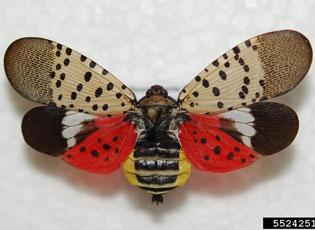Seek and Destroy: the Spotted Lanternfly

Spotted lanternfly by Lawrence Barringer, Pennsylvania Department of Agriculture, Bugwood.org CC by 3.0
Despite its name, the spotted lanternfly (Lycorma delicatula) isn’t a fly, rather it is a plant hopper, which is native to China, India and Vietnam. The first infestation in the United States was reported in Pennsylvania in 2014; this insect has now been detected in Connecticut, Delaware, Massachusetts, Maryland and New York. The first Maryland record was found in 2018 in Cecil County and subsequent records have been found in northeast Maryland this year.
The spotted lanternfly undergoes incomplete metamorphosis. After it hatches from an egg, the black and white speckled juveniles (nymphs) will continue to feed and molt multiple times. The first three juvenile stages (instars) are black and white in color, while the fourth and final instar is red, black and white. Adults are often mistaken for moths due to their broad, colorful wings.

Spotted lanternfly eggs (left) by: Pennsylvania Department of Agriculture, Bugwood.org, Spotted lanternfly early instars (middle), late instar (top right) and adult bottom right) by: Lawrence Barringer, Pennsylvania Department of Agriculture, Bugwood.org
Like other plant hoppers, the spotted lanternfly feeds on plant tissues. It has been found to primarily host on the invasive tree of heaven (Ailanthus altissima), but it will also readily feed on native species, such as apples, birch, cherry, grape, lilac, maple, poplar, sycamore, stone fruits and willows. Of particular concern is the damage this species poses to vineyards in the United States. It is estimated that there are over 70 species of woody plants that the lanternfly attacks. Adults and nymphs feed on phloem tissue that conducts food from the leaves to the rest of the plant. Later in the growing season, particularly in the fall, adults and juveniles tend to feed in groups, causing considerable damage and excreting waste (honeydew) that often results in sooty mold infestations. The extensive feeding can also create oozing wounds on host trees, making them susceptible to secondary infections. Some trees that have been fed upon will wilt or lose branches, while others will die.
At this time, control measures for the spotted lanternfly are limited. The lanternfly is susceptible to broad spectrum insecticides like pyrethroids. However, studies in Korea have found this species can rapidly recolonize treated vineyards. Sticky traps around trees have been found to control nymphs, but many non-target species have also perished on the sticky traps. Placing wire or fencing around the sticky traps will prevent most large animals, like birds and snakes, from getting stuck, but smaller organisms, like native insects, will still be at risk. Until a lanternfly-specific trap is developed, it may not be advisable to employ sticky traps.
The best action to help combat spotted lanternflies is to prevent potential hitchhikers. Become familiar with the life stages of the spotted lanternfly and Look Before You Leave (PDF), particularly if you are transporting items from spotted lanternfly infested areas.
If you observe any egg masses or insects which look similar to this, please try to collect them, and inform the Maryland Department of Agriculture at (410) 841-5920 or DontBug.MD@maryland.gov as soon as possible.
Homeowners can reference the “Spotted Lanternfly Management for Homeowners” factsheet available through Pennsylvania State University Extension.
References:
Dara, S.K., L. Barringer, and S.P. Arthurs. 2015. Lycorma delicatula (Hemiptera: Fulgoridae): a new invasive pest in the United States. Journal of Integrated Pest Management 6(1).
Park, J. D., M. Y. Kim, S. G. Lee, S. C. Shin, J. H. Kim, and I. K. Park. 2009. Biological characteristics of Lycorma delicatula and the control effects of some insecticides. Korean Journal of Applied Entomology. 48: 53-57.
Spotted Lanternfly. 2019. https://mda.maryland.gov/plants-pests/pages/spotted-lantern-fly.aspx Accessed September 18, 2019.
Happy Fall!
Fall is my favorite time of year. I love the sights and smells as the summer fades, and it is a great time to be out in the garden. Currently, many animals are in the midst of migration, and we are having some record breaking dragonfly migration swarms this year! As fall unfolds, here are a few things to consider this time of year:
In addition, last year’s rainy summer, coupled with this year’s drought and other factors, have taken a toll on oaks in our region. The University of Maryland Extension has put together an informative and concise article on Why Oak Trees are Declining. If you are in need of trees and shrubs for conservation or lumber, check out the Maryland State Tree Nursery which is accepting orders for Spring 2020.
In this issue, you can learn about a lovely native wildflower, the New England aster, as well as a native group of bees called sweat bees that help to pollinate New England aster and its relatives. In addition, with advances in plant research, we are learning more about how cultivars affect our landscapes. Finally, learn about an up and coming invasive insect in Maryland, the spotted lanternfly, and how to report if you see one in the state.
Happy Habitats,
Kerry Wixted
Click here to have HabiChat—the quarterly backyard wildlife habitat newsletter from the Wild Acres program—delivered right to your inbox!
In this Issue
Native Animal Profile: Sweat Bees (aka Halictid Bees)
Native Plant Profile: New England Aster (Symphyotrichum novae-angliae)
The Cultivar Question



 1-888-373-7888
1-888-373-7888 233733
233733